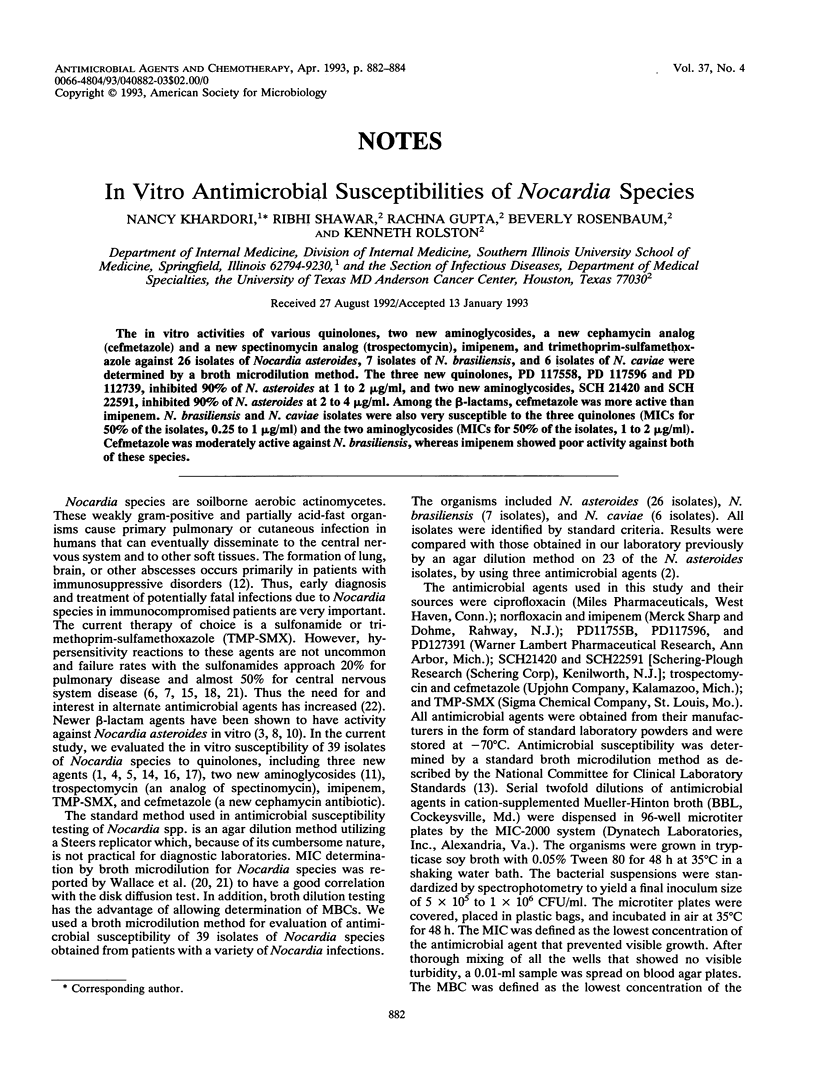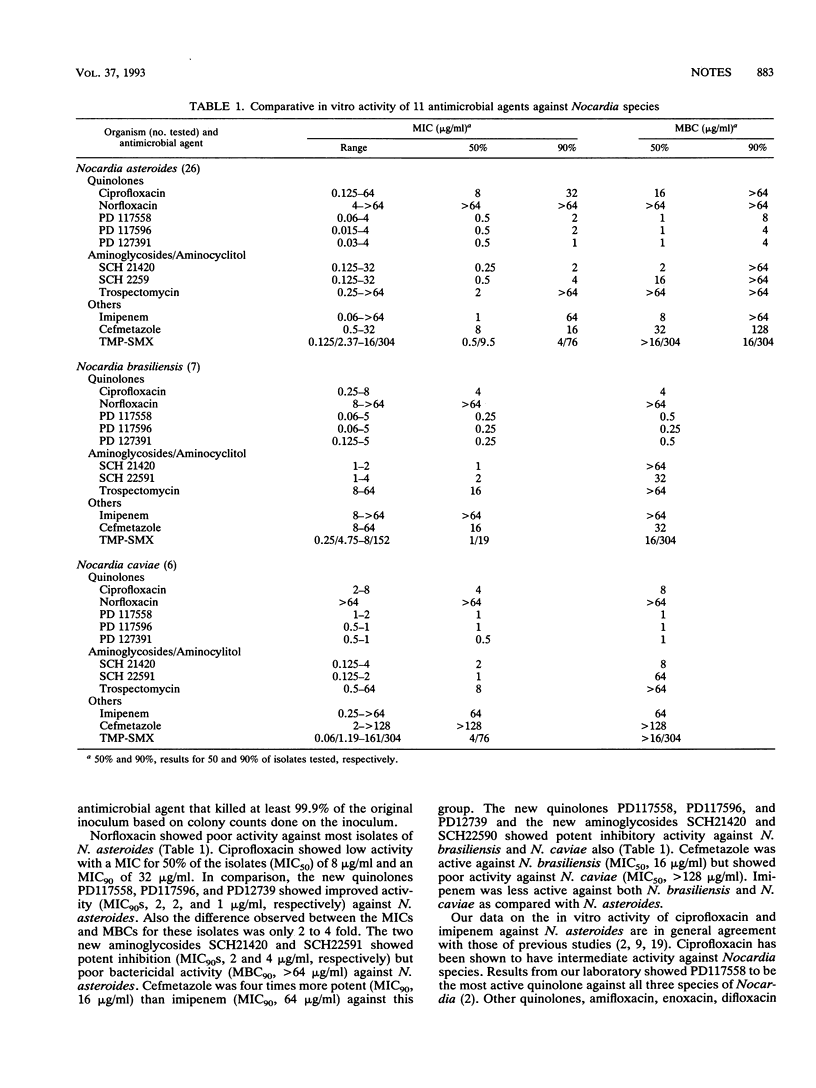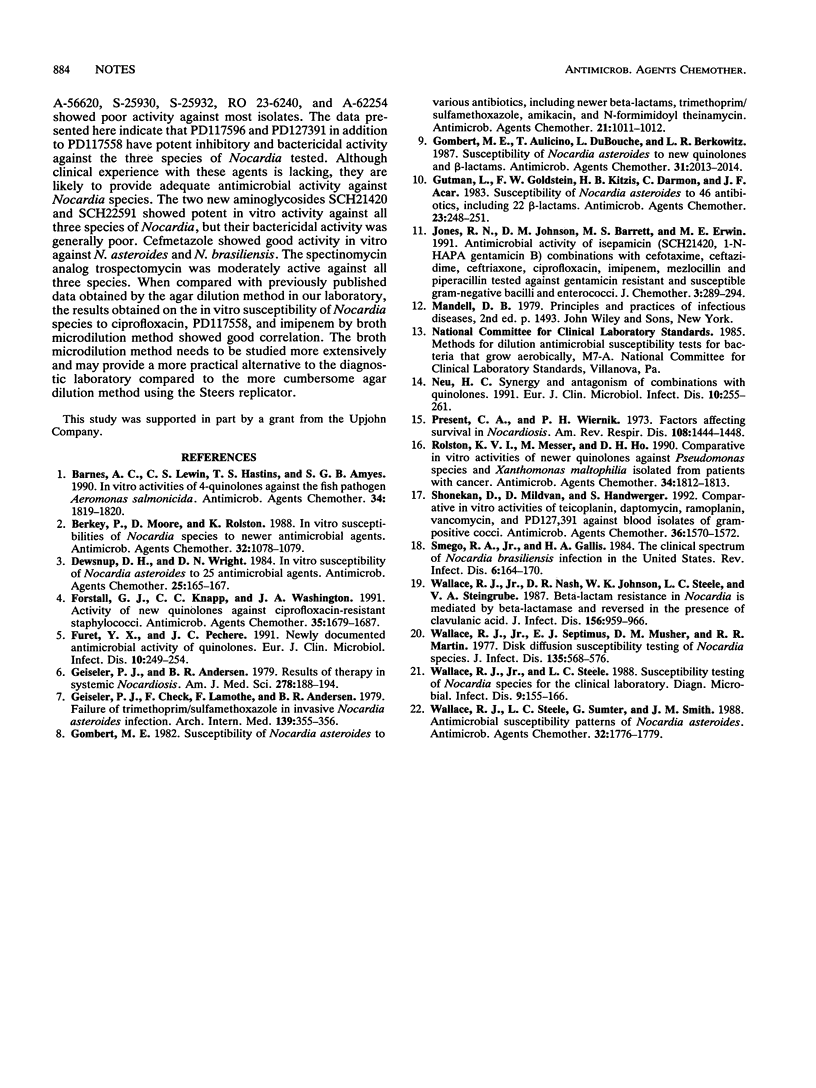Abstract
The in vitro activities of various quinolones, two new aminoglycosides, a new cephamycin analog (cefmetazole) and a new spectinomycin analog (trospectomycin), imipenem, and trimethoprim-sulfamethoxazole against 26 isolates of Nocardia asteroides, 7 isolates of N. brasiliensis, and 6 isolates of N. caviae were determined by a broth microdilution method. The three new quinolones, PD 117558, PD 117596 and PD 112739, inhibited 90% of N. asteroides at 1 to 2 micrograms/ml, and two new aminoglycosides, SCH 21420 and SCH 22591, inhibited 90% of N. asteroides at 2 to 4 micrograms/ml. Among the beta-lactams, cefmetazole was more active than imipenem. N. brasiliensis and N. caviae isolates were also very susceptible to the three quinolones (MICs for 50% of the isolates, 0.25 to 1 microgram/ml) and the two aminoglycosides (MICs for 50% of the isolates, 1 to 2 micrograms/ml). Cefmetazole was moderately active against N. brasiliensis, whereas imipenem showed poor activity against both of these species.
Full text
PDF


Selected References
These references are in PubMed. This may not be the complete list of references from this article.
- Barnes A. C., Lewin C. S., Hastings T. S., Amyes S. G. In vitro activities of 4-quinolones against the fish pathogen Aeromonas salmonicida. Antimicrob Agents Chemother. 1990 Sep;34(9):1819–1820. doi: 10.1128/aac.34.9.1819. [DOI] [PMC free article] [PubMed] [Google Scholar]
- Berkey P., Moore D., Rolston K. In vitro susceptibilities of Nocardia species to newer antimicrobial agents. Antimicrob Agents Chemother. 1988 Jul;32(7):1078–1079. doi: 10.1128/aac.32.7.1078. [DOI] [PMC free article] [PubMed] [Google Scholar]
- Dewsnup D. H., Wright D. N. In vitro susceptibility of Nocardia asteroides to 25 antimicrobial agents. Antimicrob Agents Chemother. 1984 Feb;25(2):165–167. doi: 10.1128/aac.25.2.165. [DOI] [PMC free article] [PubMed] [Google Scholar]
- Forstall G. J., Knapp C. C., Washington J. A. Activity of new quinolones against ciprofloxacin-resistant staphylococci. Antimicrob Agents Chemother. 1991 Aug;35(8):1679–1681. doi: 10.1128/aac.35.8.1679. [DOI] [PMC free article] [PubMed] [Google Scholar]
- Furet Y. X., Pechère J. C. Newly documented antimicrobial activity of quinolones. Eur J Clin Microbiol Infect Dis. 1991 Apr;10(4):249–254. doi: 10.1007/BF01966997. [DOI] [PubMed] [Google Scholar]
- Geiseler P. J., Andersen B. R. Results of therapy in systemic nocardiosis. Am J Med Sci. 1979 Nov-Dec;278(3):188–194. doi: 10.1097/00000441-197911000-00001. [DOI] [PubMed] [Google Scholar]
- Geiseler P. J., Check F., Lamothe F., Andersen B. R. Failure of trimethoprim/sulfamethoxazole in invasive Nocardia asteroides infection. Arch Intern Med. 1979 Mar;139(3):355–356. [PubMed] [Google Scholar]
- Gombert M. E., Aulicino T. M., duBouchet L., Berkowitz L. R. Susceptibility of Nocardia asteroides to new quinolones and beta-lactams. Antimicrob Agents Chemother. 1987 Dec;31(12):2013–2014. doi: 10.1128/aac.31.12.2013. [DOI] [PMC free article] [PubMed] [Google Scholar]
- Gombert M. E. Susceptibility of Nocardia asteroides to various antibiotics, including newer beta-lactams, trimethoprim-sulfamethoxazole, amikacin, and N-formimidoyl thienamycin. Antimicrob Agents Chemother. 1982 Jun;21(6):1011–1012. doi: 10.1128/aac.21.6.1011. [DOI] [PMC free article] [PubMed] [Google Scholar]
- Gutmann L., Goldstein F. W., Kitzis M. D., Hautefort B., Darmon C., Acar J. F. Susceptibility of Nocardia asteroides to 46 antibiotics, including 22 beta-lactams. Antimicrob Agents Chemother. 1983 Feb;23(2):248–251. doi: 10.1128/aac.23.2.248. [DOI] [PMC free article] [PubMed] [Google Scholar]
- Jones R. N., Johnson D. M., Barrett M. S., Erwin M. E. Antimicrobial activity of isepamicin (SCH21420, 1-N-HAPA gentamicin B) combinations with cefotaxime, ceftazidime, ceftriaxone, ciprofloxacin, imipenem, mezlocillin and piperacillin tested against gentamicin-resistant and susceptible gram-negative bacilli and enterococci. J Chemother. 1991 Oct;3(5):289–294. doi: 10.1080/1120009x.1991.11739108. [DOI] [PubMed] [Google Scholar]
- Neu H. C. Synergy and antagonism of combinations with quinolones. Eur J Clin Microbiol Infect Dis. 1991 Apr;10(4):255–261. doi: 10.1007/BF01966998. [DOI] [PubMed] [Google Scholar]
- Presant C. A., Wiernik P. H., Serpick A. A. Factors affecting survival in nocardiosis. Am Rev Respir Dis. 1973 Dec;108(6):1444–1448. doi: 10.1164/arrd.1973.108.6.1444. [DOI] [PubMed] [Google Scholar]
- Rolston K. V., Messer M., Ho D. H. Comparative in vitro activities of newer quinolones against Pseudomonas species and Xanthomonas maltophilia isolated from patients with cancer. Antimicrob Agents Chemother. 1990 Sep;34(9):1812–1813. doi: 10.1128/aac.34.9.1812. [DOI] [PMC free article] [PubMed] [Google Scholar]
- Shonekan D., Mildvan D., Handwerger S. Comparative in vitro activities of teicoplanin, daptomycin, ramoplanin, vancomycin, and PD127,391 against blood isolates of gram-positive cocci. Antimicrob Agents Chemother. 1992 Jul;36(7):1570–1572. doi: 10.1128/aac.36.7.1570. [DOI] [PMC free article] [PubMed] [Google Scholar]
- Smego R. A., Jr, Gallis H. A. The clinical spectrum of Nocardia brasiliensis infection in the United States. Rev Infect Dis. 1984 Mar-Apr;6(2):164–180. doi: 10.1093/clinids/6.2.164. [DOI] [PubMed] [Google Scholar]
- Wallace R. J., Jr, Nash D. R., Johnson W. K., Steele L. C., Steingrube V. A. Beta-lactam resistance in Nocardia brasiliensis is mediated by beta-lactamase and reversed in the presence of clavulanic acid. J Infect Dis. 1987 Dec;156(6):959–966. doi: 10.1093/infdis/156.6.959. [DOI] [PubMed] [Google Scholar]
- Wallace R. J., Jr, Septimus E. J., Musher D. M., Martin R. R. Disk diffusion susceptibility testing of Nocardia species. J Infect Dis. 1977 Apr;135(4):568–576. doi: 10.1093/infdis/135.4.568. [DOI] [PubMed] [Google Scholar]
- Wallace R. J., Jr, Steele L. C., Sumter G., Smith J. M. Antimicrobial susceptibility patterns of Nocardia asteroides. Antimicrob Agents Chemother. 1988 Dec;32(12):1776–1779. doi: 10.1128/aac.32.12.1776. [DOI] [PMC free article] [PubMed] [Google Scholar]
- Wallace R. J., Jr, Steele L. C. Susceptibility testing of Nocardia species for the clinical laboratory. Diagn Microbiol Infect Dis. 1988 Mar;9(3):155–166. doi: 10.1016/0732-8893(88)90025-9. [DOI] [PubMed] [Google Scholar]


